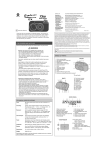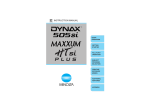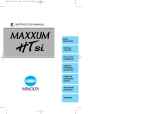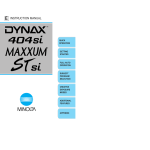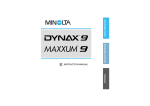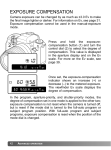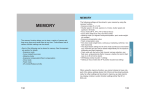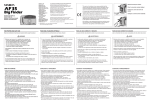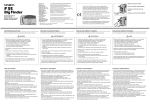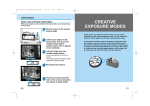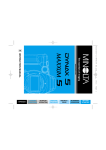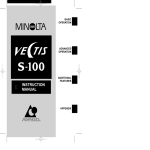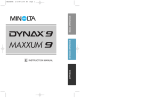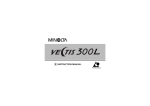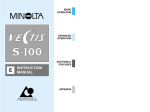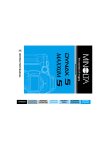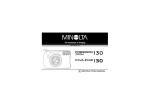Download Minolta Maxxum XTsi 35mm SLR Camera
Transcript
M-MODE – MANUAL TAKING TIME EXPOSURES (buLb) M-Mode Flash When the built-in flash is up or an attached accessory flash is on, it will fire each time a picture is taken. Flash exposure is controlled by the camera’s TTL automatic flash metering system. 1. Press the flash-mode button to pop-up the built-in flash. • will appear in the data panel. 2. Turn the control dial to select any shutter speed up to 1/125th of a second. 3. Press the exposurecompensation button and turn the control dial to select the aperture. Set the shutter speed to bulb when you want to take time exposures. When bulb is selected, the shutter remains open as long as the shutter-release button is pressed. 1. Mount the camera on a tripod. 2. Set the camera to M-mode, then turn the control dial until appears in the data panel. 3. Press the exposurecompensation button and turn the control dial to select the aperture. • Refer to the flash range table on page 26 to determine the aperture setting and the flash range. Cancelling the Flash Push the built-in flash down or turn the accessory flash off. • will be displayed in the data panel. 4. Compose the scene and focus on your subject. • If the scene is too dark for autofocus to operate, press the focus-mode button and focus the lens manually (p54). Continued on next page. 48 49 TAKING TIME EXPOSURES (buLb) 5. Firmly press the eyepiece cap into the eyepiece. • The eyepiece cap prevents light from entering thru the viewfinder and affecting the metered exposure. 6. Press and hold the shutterrelease button to take the picture. • The shutter remains open as long as the button is pressed. Attaching the Remote Cord To reduce image blur, attach either the Remote Cord RC-1000S or RC-1000L (sold separately). 1. Flip the remote-controlterminal cover up. 2. Insert the plug into the terminal. Do not use the Wireless Controller IR-1N with this camera. Permanent damage will occur. 50 ADDITIONAL F E AT U R E S FOCUS – Wide Focus Area Wide focus area uses the camera’s three focus sensors to automatically focus on your subject. The wide focus area provides greater framing flexibility and makes it easier for the camera to focus on moving subjects. Wide focus area is the camera’s standard focus mode. The camera determines which sensor is focusing on your subject and sets the focus accordingly. • The focus areas are not visible in the viewfinder frame. FOCUS – Spot AF Spot AF uses the center focus sensor and the current metering mode (p56) to lock focus and exposure. The focus and exposure settings remain locked until the spot AF button is released. 1. Place your subject inside the spot-focus area. 2. Press and hold the spot AF button. • Focus is confirmed when the viewfinder. appears in The focus area indicator in the viewfinder tells you which sensor the camera is using. will appear in the viewfinder, indicating the center focus sensor is being used. 3. Press the shutter-release button all the way down to take the picture. • Focus and exposure readings are held until the spot AF button is released. 52 53 FOCUS – Manual Focus Focus the lens manually when autofocus is not suitable and focus hold is not possible. The autofocus system will monitor focus and indicate when a subject in the focus frame is in focus. 1. Press the focus-mode button. will appear in the data panel. FOCUS – AF Illuminator The AF Illuminator is a secondary function of the built-in flash. When the scene is too dark for the camera to focus accurately, the built-in flash fires a few short bursts when the shutterrelease button is pressed partway down to provide the illumination necessary for the camera to focus on your subject. • Pressing the spot AF button also activates the AF illuminator. 2. Turn the focusing ring until your subject appears sharp and focused. • appears in the viewfinder when the subject in the focus frame is in focus. • Press the focus-mode button again to return to the autofocus mode. • The range of the AF Illuminator flash is approximately one to five meters. • The AF illuminator will not fire in continuous focus mode or if flash cancel ( ) is selected. • The AF illuminator will not operate with 300mm or longer single focal length lenses. • The AF illuminator will not operate with 3x-1x Macro Zoom. • When an accessory flash is attached, its AF illuminator will be active in place of the camera’s AF illuminator. AF Power Zoom and xi-Series Lenses Pull and turn the control ring until your subject appears sharp. 54 Custom Function 9 (p82) lets you cancel the built-in flash’s AF illuminator if it will interfere with your subject or is inappropriate. 55 EXPOSURE – 14 Segment Metering Fourteen-Segment Honeycomb-Pattern Metering uses information from the autofocus system to set the metering pattern according to the position of the main subject. The light metered by each applicable segment is then evaluated to determine the degree of spot-lighting or backlighting present in your scene. The focus-area indicator displays the sensor being used when the shutter release button is pressed partway down. Fourteen-Segment Honeycomb-Pattern Metering is the camera’s standard metering mode and is appropriate for most photographic situations. EXPOSURE – Spot Metering Use only the center metering segment to lock the exposure settings without locking the focus. The exposure remains locked until the spot/AE lock button is released. • Pressing the spot/AE lock button sets the flash to slow sync mode (p67). 1. Place the spot-metering area on the subject whose exposure you want to lock. 2. Press and hold the spot/AE lock button. • and the locked exposure will be displayed in the viewfinder. 3. Recompose the scene as desired, then press the shutter-release button all the way down to take the picture. • The exposure is held until the spot/AE lock button is released. 56 57 EXPOSURE – Exposure Compensation The metering system in this camera averages the readings from each active metering segment to determine an exposure that will achieve an average middle grey tone on the film. EXPOSURE – Setting the ISO Manually Set the film speed manually when you want to override the DX-coded film speed or when using non-DX-coded film. Film speeds can be set from ISO 6 to 6400 in 1/3EV increments. Film must be loaded before the ISO can be changed. 1. Turn the function dial to ISO. Compensated Exposure Bright scenes such as snow or beach scenes are often underexposed. Dark scenes are often overexposed. Exposure compensation lets you adjust the metered exposure +/– 3 stops in 1/2 stop increments. Metered Exposure This effect is most visible when slide film is being used. 2. Press the function button and turn the control dial until the desired ISO value appears in the data panel. Press the exposurecompensation button and turn the control dial until the desired compensation value appears in the data panel. • Exposure compensation remains until it is reset or cancelled. • To cancel exposure-compensation, repeat the above procedure and select 0.0 or press the program-reset button. • Exposure compensation is not available in M-mode. 58 59 EXPOSURE – Bracketing EXPOSURE – Bracketing 3. Select the desired drive mode. • The drive mode is initially set to single ( ) or continuous ( ) whichever was set with exposure bracketing last. Metered Exposure 1/2 Stop Under 1/2 Stop Over 4. Focus on and frame your subject, then press the shutter-release button all the way down to take the picture. This function automatically exposes a 3 frame 1/2 stop increment bracketed series. The order of the exposures will be the metered exposure, 1/2-stop under the metered exposure, 1/2 stop over the metered exposure. Hold the shutter-release button down until the series is finished. Press the shutter-release button for each exposure. • The automatic bracketing feature cannot bracket flash exposures. This effect is most visible when slide film is being used. 1. Turn the function dial to . • Exposure is locked on the first frame of the series. • The exposure settings will change automatically. Flash Notes 2. Press the function button and turn the control dial until appears in the data panel. • 60 appears in the frame counter after the function button is released. • The built-in flash is set to flash cancel ( ) when bracketing is selected. • An attached Minolta accessory flash will be set to off when bracketing is selected. • If an AF series flash is mounted and on when bracketing is selected, will blink in the data panel and the shutter will lock until the flash is turned off. 61 EXPOSURE – Bracketing EXPOSURE – Multiple Exposure The multiple-exposure function makes it possible to expose two or more images on the same frame. Cancelling Bracketing 1. Turn the function dial to . 2. Press the function button and turn the control dial until OFF appears in the data panel. 1. Turn the function dial to Sliding the main switch to LOCK in the middle of a bracketing series resets the bracketing series to the first frame ( ). . 2. Press the function button and turn the control dial until appears in the data panel. • appears in the frame counter. Bracketing with the Exposure Compensation Button While pressing the exposurecompensation button, press the shutter release button all the way down and hold. • The camera automatically exposes a three frame bracketed series. • Releasing either button before the series is complete cancels the exposure series. 3. Compose the scene, then press the shutter-release button all the way down to take the first exposure. Continued on next page. 62 63 EXPOSURE – Multiple Exposure EXPOSURE – Multiple Exposure Metering Multiple Exposures blinks in the data panel, indicating the next exposure will be the last in the series. The meter in your camera determines exposure (EV) based on the assumption that only one exposure will be made on each frame. When making multiple exposures, the EV for each additional exposure needs to be reduced or over exposure will result. • To take more than 2 exposures, repeat steps 1 and 2 until ME glows in the data panel. • Compensation is not necessary if all of the exposures have dark backgrounds and the subjects of the exposures will not overlap. 4. Press the shutter-release button all the way down again to take the last exposure. • Multiple-exposure mode is cancelled after the last exposure has been taken. Compensate the exposures as follows: Number of Exposures Exposure Adjustment Cancelling Multiple Exposure 1. Turn the function dial to . 2. Press the function button and turn the control dial until OFF appears in the data panel. • The above corrections are intended as a general guideline. Some testing may be necessary to produce the desired results. • Exposure can be compensated in 1/2 EV increments using the exposure compensation function (p58) and in 1/3 EV increments by changing the ISO manually (p59). Sliding the main switch to LOCK does not cancel multiple exposure mode. 64 65 FLASH – High-Speed Sync The maximum sync speed for this camera is 1/125. However, with the 5400HS accessory flash (sold separately) shutter speeds up to 1/4000 can be used. High-speed sync (HSS) allows faster shutter speeds when fill flash is used on moving subjects outdoors. FLASH – Slow Sync In P and A-modes, slow-shutter sync sets a slower shutter speed to increase the background or ambient lighting exposure in a flash picture. Flash output will automatically be decreased to maintain a correct exposure of your subject. Slow-shutter Sync High-speed Sync HSS also lets you use large aperture/high shutter-speed combinations to separate your subject from the background by limiting the depth-of-field. Conventional Fill Flash Conventional Flash 1. Frame your subject. Attach the 5400HS flash and set it to standard mode. • The camera will automatically switch to HSS mode and H will appear in the viewfinder and data panel. • HSS cannot be used under fluorescent lights. • Flash and color meters cannot meter the flash when high-speed sync is selected. Refer to the 5400HS instruction manual for details. 66 2. While pressing the spot/AE lock button, press the shutterrelease button all the way down to take the picture. • If the background is bright or a large aperture is set (A-mode), the shutter speed may not be reduced. • Use a tripod if the shutter speed becomes too slow to allow sharp, hand-held pictures after you press the spot/AE lock button. • and the locked exposure will be displayed in the viewfinder. 67 FLASH – Wireless/Remote Flash Normal Flash Wireless/Remote Flash Wireless/Remote Ratio Flash 68 Wireless/Remote Flash is available with the Minolta 5400HS, 5400xi, and 3500xi accessory flashes. Wireless/Remote flash lets you experience the creative control available with an accessory flash. In Wireless/Remote flash mode, the off-camera flash is triggered by a coded signal from the camera’s built-in flash when you press the shutter-release button. When proper exposure has been received, another signal cuts the accessory flash off. You can also achieve a 2:1 lighting ratio automatically. When remote ratio flash is selected, the off-camera flash provides 2/3 of the full exposure while the built-in flash provides the remaining 1/3. FLASH – Wireless/Remote Flash Setting Wireless/Remote Flash Mode 1. Attach the accessory flash to the camera, then turn the camera and the flash on. 2. Turn the function dial to WL. 3. Press the function button and turn the control dial until WL and On appear in the camera’s data panel. 4. Detach the accessory flash, then press the camera’s flash mode button to raise the builtin flash. 69 FLASH – Wireless/Remote Flash FLASH – Wireless/Remote Flash Taking Pictures in Wireless/Remote Flash Mode 2. Wait until both flash units are fully charged. The off-camera flash will provide all of the exposure. • appears in the viewfinder when the builtin flash is charged. • When the off-camera flash is charged, its AF illuminator will blink. 1. Position your camera and 3500xi flash unit using the information on this page. • If you are not using the 3500xi flash, refer to your flash instruction manual for the correct camera to subject and flash to subject distances. Press the spot/AE lock button to test fire the accessory flash. 3. Press the shutter-release button all the way down to take the picture. Wireless/Remote Ratio Flash Aperture Camera – Subject Distance 3500xi – Subject Distance f/2.8 1.4 – 5.0m (4.6 – 16 ft.) 1.0 – 5.0m (3.3 – 16 ft.) f/4.0 1.0 – 5.0m (3.3 – 16 ft.) 0.7 – 4.5m (2.3 – 14.5 ft.) f/5.6 1.0 – 5.0m (3.3 – 16 ft.) 0.5 – 3.2m (2.3 – 10.5 ft.) Press the flash-mode button when taking the picture. Both flashes will fire when the shutter is release at a 2:1 ratio. The built-in flash will provide 1/3 and the accessory flash will provide 2/3 of the total exposure. CAUTION: • Calculated for ISO 100 film only. 70 Set CUSt – 8 (Spot/AE Lock) to setting 1 when Wireless/Remote flash mode is on. If setting 2 is selected, test firing the flash will activate slow-shutter sync (p82). 71 FLASH – Wireless/Remote Flash Cancelling Wireless/Remote Flash Mode 1. Attach the accessory flash to the camera, then turn the flash on. FOR OWNERS OF THE PANORAMA MODEL Select panorama mode to take panorama-format images any time, even in the middle of the roll. • Panorama mode does not change the number of exposures on a roll of film. • The top and bottom parts of the film will not be exposed. • The imprinting position for the quartz data back is automatically changed when panorama format is selected. 1. Turn the panorama switch to P. 2. Turn the function dial to WL. • The viewfinder changes to a panorama format. 3. Press the function button and turn the control dial until WL and OFF appear in the camera’s data panel. 4. Detach the accessory flash. 2. Frame your subject in the viewfinder and take the picture. A B After taking panoramic images… Attach one of the supplied panoramaformat stickers to the film cartridge. Two sticker types are available. Use A if all the images on the roll were exposed in panorama format. Use B if the roll contains both panorama and standard format images. • Contact the nearest Minolta Service Facility to obtain additional panorama stickers. 72 73 FOR OWNERS OF THE QUARTZ DATE MODEL The Quartz-data function lets you record the date or time onto the lower-right corner of the photograph. The quartz data back has an automatic calendar through the year 2019. • Imprinted data may be difficult to read if the lower-right corner of the photograph is bright or non-uniform. • Imprinting size and position may differ according to printing conditions. • Do not use the data back when temperatures exceed the operating range of 0 to 50 °C (32 to 122 °F). FOR OWNERS OF THE QUARTZ DATE MODEL Setting the Date/Time 1. Press the mode button to choose the data imprinting format. • M will appear above the month. Print indicator Select button Mode button Adjust button 2. Use the select button (SEL) to move between different parts of the displayed data. • The selected part will blink, indicating that it is the data to be changed. Exposing the Date/Time Before taking the picture… 1. Press the mode button to choose the data imprinting format. • The display changes as follows: 3. Press the adjust button (ADJ) to change the data to the correct value. • Data continues changing as long as the button is held down. • When the time is displayed and : is blinking, pressing the adjust button resets the seconds counter to zero (not shown). 4. When all data is correct, press the select button (SEL) until the data stops blinking. 2. Take the picture. • If the print indicator blinks after the shutter is released, the data was exposed. 74 75 FOR OWNERS OF THE QUARTZ DATE MODEL Replacing the Battery The quartz data back uses a CR2025 lithium battery, located on the inside of the back cover. Replace the battery if the display or imprinted data becomes dim. 1. Open the back cover. CUSTOM FUNCTIONS Using the custom functions, you can tailor selected camera settings to suit your shooting style or preferences. The functions you can customize are explained on pages 78-82. Setting the Custom Functions 1. Turn the function dial to CUST. 2. Using a coin or similar object, turn the battery cover counter-clockwise, then remove it. 2. Turn the control dial to select the number of the custom function you want to change. 3. Press the function button and turn the control dial to select the desired setting. 3. Remove the old battery and replace it with a new one. 4. Turn the function dial to any position other than CUST. • The + side should face up. • The shutter cannot be released if the function dial is set to CUST. 4. Replace the battery cover, then reset the date and time. To reset all of the custom functions to their default setting (1)… 1. Slide the main switch to LOCK. 2. Turn the function dial to CUST. 3. Press the function button and slide the main switch from LOCK to ON. • 76 will blink in the data panel. 77 CUSTOM FUNCTIONS CUSTOM FUNCTIONS Cust 1 – AF Release Priority Cust 4 – DX Memory 1 – AF priority 1 – DX Memory Off Shutter will not release until or appears in the viewfinder. 2 – Release Priority Shutter releases even if the focus cannot be confirmed. Use Release priority when photographing moving subjects. • When continuous-advance mode is selected, the camera will not update the focus while the shutter-release button is pressed. Film speed is always set to the DX-coded ISO. Non-DX-coded film is set to the ISO of the previous roll. 2 – DX Memory On Changes to the film speed for a DX coded roll are saved and applied to future rolls with the same DX coded ISO. Use to consistently over/under-expose a specific film type. • Film must be loaded before the ISO can be changed. Cust 2 – Film Rewind Start 1 – Automatic Cust 5 – Flash Control in P Mode Film is automatically rewound at the end of the roll. 1 – Autoswitchover 2 – Manual Built-in flash pops-up when shutter-release button is pressed partway down. Flash will fire when necessary. Press the manual-rewind button to initiate rewind. (p29). 2 – Fill Flash (Manual Switchover) Flash-mode button must be pressed to raise the built-in flash (p27). Flash will fire every time the shutter is released. Cust 3 – Film Tip 1 – Film is completely rewound into the cartridge. • The TTL exposure system will ensure correct exposure. • Push the built-in flash down to select flash cancel ( ). 2 – Leader is left out of the cartridge after rewind. • Sliding the main switch to LOCK during rewind causes the film to be rewound into the cartridge when the power is switched back on. 78 79 CUSTOM FUNCTIONS CUSTOM FUNCTIONS Cust 6 – Focus-hold button (LENS) Cust 7 – Spot AF button The mounted lens must have a focus hold button. 1 – Focus Hold Pressing the focus-hold button on the lens locks the focus. 1 – Spot Focus Press the Spot AF button to lock the focus using the center focus sensor (p53). 2 – Selectable focus area Press the Spot AF button and turn the control dial to specify the desired local focus area. 2 – Spot Focus Pressing the focus-hold button on the lens selects the center focus sensor (p53). 3 – Continuous Focus Select this setting when focusing on moving subjects. Pressing the focus-hold button on the lens selects continuous focus. • The selected focus area is displayed in the viewfinder data panel. • The focus area remains selected until it is changed or CUSt – 7 is returned to setting 1. • When the RF 500mm lens or the AF Power Zoom 35-80mm lens is attached, only the center local focus area can be selected. Local Focus Area Locations The sequence is: Wide focus area 80 Left local focus area Center spot focus area Right local focus area 81 CUSTOM FUNCTIONS Cust 8 – Spot/AE Lock button 1 – Press to activate Spot area is used for metering until the spot button is released. 2 – Press once to activate, press again to cancel. Spot metering area is used for metering until the spot/AE lock button is pressed again. APPENDIX • Slow-shutter sync is set when the flash is selected. Cust 9 – AF Illuminator (built-in flash) 1 – AF IIluminator on When the built-in flash is up, its AF illuminator will fire when necessary to assist focus. • The AF illuminator does not fire when flash cancel ( ) is selected. Program Reset Button Press the program-reset button to return the following camera functions to their program settings. FUNCTION Exposure mode 2 – AF Illuminator cancelled The built-in flash’s AF illuminator will not fire. Other flash functions will operate normally. • An attached accessory flash’s AF illuminator will not be cancelled. 1 – Grip sensor activated Eyepiece sensor is activated when the grip sensor is tripped. 2 – Main switch activated Eyepiece sensor is activated when the main switch is in the ON position. Use this setting when the grip sensor is not being tripped (user wearing gloves). • Slide the main switch to LOCK when the camera is not being used. 82 P mode Focus mode Autofocus Flash mode Auto-on Exposure Compensation Film-drive mode Cust 10 – Eyepiece Sensor P-MODE SETTING +/– 0 Single-frame advance Self-timer Cancelled Wireless/Remote Flash Cancelled Bracketing Cancelled Multiple Exposure Cancelled • Date, red-eye reduction, ISO settings, and custom function settings will not change. • Pressing the program-reset button will also reset an attached dedicated accessory flash’s program settings. Refer to the flash instruction manual for details. ACCESSORY INFORMATION This camera is designed to work specifically with lenses and accessories manufactured and distributed by Minolta. Using incompatible accessories with this camera may result in unsatisfactory performance or damage the camera and accessories. Compatibility of Accessories Lenses • All Minolta AF lenses can be used with this camera. • MD and MC series lenses (manual focus) cannot be used with this camera. ACCESSORY INFORMATION Accessory Flash Control When using an accessory flash, the desired flash mode can be selected using the camera or the flash. CAMERA Press the flash-mode button and turn the control dial to select the desired flash mode. • The camera transfers data to the accessory flash immediately. Flashes • All Minolta i, si, and HS series flash units, and the Vectis SF-1 flash, are compatible with this camera. The flash will always fire when the flash unit is on. (Unless Custom Function #5 is set to Autoflash (setting 1). In this case, the flash will fire only when necessary when it is on and the camera is in Full-Auto and Subject Program modes.) • The Flash Shoe Adapter FS-1100 is required to mount AF series flash units (4000AF, 2800AF, 1800AF, and Macro flash 1200AF). • When the FS-1100 is used… - The flash will fire every time the shutter is released. - The AF illuminator will not activate. - The built-in flash is set to fill flash when the accessory flash is removed. • X-series flashes and flashes sold by other manufacturers cannot be used with this camera. FLASH Press the flash’s ON/OFF button to select the desired flash mode. • Data is not transferred from the flash until the shutter-release button is pressed partway down. • Fill flash cannot be selected when the camera is set to Full-Auto or any of the Subject Program modes. Others • The following accessories are not compatible with this camera: Control Grip CG-1000 Data Receiver DR-1000 Creative Expansion Cards Anglefinder Magnifier Wireless Controller IR-1N * Permanent damage will occur if the Wireless Controller IR-1N is used with this camera. 84 85 ACCESSORY INFORMATION EXPOSURE WARNINGS For owners of the optional lens kits Indicators will blink in the viewfinder or data panel when there is a problem with the exposure. Lens Hood Flare is non-image forming light that degrades image quality. A lens hood improves image quality by reducing flare. • Remove a lens hood before using the camera’s built-in flash. Fit the lens hood into the mount at the end of the lens barrel, then turn the hood clockwise until it stops. MODE Construction: Angle of View: Min. Focus Distance: Max. Magnification: Min. Aperture: Filter Diameter: Dimensions: Weight: 7 elements/ 7 groups 63° – 34° 0.5m (1.6 ft.) 0.15X f/22–27 49mm 68.5 x 63mm 210g (7.44 oz) 10 elements/10 groups 75° – 30° 0.38m (1.2 ft.) 0.26X f/22–38 62mm 69 x 74mm 230g (8.125 oz) • Specifications are based on the latest information available at the time of printing and are subject to change without notice. 86 ACTION Light level is beyond the range of available shutter speeds and apertures. P Scene or subject brightness is beyond the camera’s metering range. A The required shutter speed is beyond the range of the camera. Select a larger or smaller aperture until the display stops blinking. S The required aperture is beyond the range of the lens. Select a faster or slower shutter speed until the display stops blinking. Lens Specifications AF Zoom 28 – 80mm f/3.5-5.6 CAUSE P A S M • To store the hood, reverse it, attach it to the lens , then replace the lens cap. AF Zoom 35 – 70mm f/3.5-4.5 DISPLAY Bright Light Use slower speed film, a neutral density (ND) filter, or reduce the light level of your surroundings. Low Light Use higher speed film or a flash. 87 TROUBLE SHOOTING TROUBLE SHOOTING Contact your nearest Minolta Service Facility if the following information does not cover the problem which you are experiencing or the condition continues. PROBLEM CAUSE SOLUTION PAGE Batteries are loaded incorrectly. Remove and reinstall the batteries. 12 Batteries are exhausted. If the camera battery is exhausted, install a new battery. 12 Situation is unsuitable for autofocus. Use focus hold or manual focus. Camera is set to manual focus mode. Press the focus mode button to return the camera to autofocus mode. Subject is too close. Check the minimum focus distance for your lens. Focus cannot be confirmed. Use focus hold or manual focus. Camera is attached to a microscope or telescope. Contact a Minolta service facility for information. – Flash fires when the shutter-release button is pressed partway down. The AF illuminator is on. This is a normal camera operation. – Flash picture is too dark. Subject is beyond flash range. Make sure the subject is within the flash range. 26 Lower part of flash picture is dark. Lens hood attached. Remove lens hood. 86 Camera Malfunction Remove and reinstall the batteries. If normal camera operation does not resume or the camera malfunctions repeatedly, contact an authorized Minolta Service Facility. 12 No display appears when the camera is switched on. Autofocus does not work when shutterrelease button is pressed partway down. Shutter cannot be released. Err appears in the data panel. 88 24/54 54 – 24/54 89 CARE AND STORAGE CARE AND STORAGE Operating Temperature and Conditions Cleaning • This camera is designed for use from -20 to 50 °C (4 to 122 °F). • Never leave your camera where it may be subjected to extreme temperatures such as the glove compartment of a car. • Data panel response time will be slow at colder temperatures. The display will temporarily darken at higher temperatures, but will restore when the temperature normalizes. • Never subject the camera to extreme humidity. • To prevent condensation from forming, place the camera in a sealed plastic bag when bringing it from cold environment to a warm environment. Allow it to come to room temperature before removing it from the bag. • The low-battery symbol may appear even with fresh batteries depending on the storage conditions. To restore camera power, repeat turning the camera on and off. • Battery capacity decreases at colder temperatures. Keep your camera and spare batteries in a warm inside pocket when shooting in cold weather. Batteries will regain some of their capacity when warmed to normal operating temperature. Storage When storing your camera for extended periods, • Always attach the protective caps. • Store in a cool, dry, and well-ventilated area away from dust and chemicals such as moth balls. For long periods, place the camera in an airtight container with a silica gel drying agent. • Periodically release the camera’s shutter to keep it operating properly. • Before using after prolonged storage, check the camera’s operation to make sure it is functioning properly. 90 • If the camera or lens barrel is dirty, wipe it gently with a soft, clean, dry cloth. If the camera or lens comes in contact with sand, gently blow away loose particles - wiping may scratch the surface. • To clean the lens surface, first brush away any dust or sand then, if necessary, moisten a lens tissue with lens cleaning fluid and gently wipe the lens in a circular motion, starting from the center. • Never place lens fluid directly on the lens. • Never touch the interior of the camera, especially the shutter and mirror, doing so may impair their alignment and movement. Dust on the mirror will not affect the picture quality. • Never use compressed air to clean the camera’s interior, it may cause damage to sensitive interior parts. • Never use organic solvents to clean the camera. • Never touch the lens surface with your fingers. Before Important Events • Check the camera’s operation carefully, or take test photographs. • Minolta is not responsible for any loss that may occur due to an equipment malfunction. Questions and Service • If you have questions about your camera, contact your local camera dealer or write to the Minolta distributor in your area. • Before shipping your camera for repair, please contact an authorized Minolta Service Facility for details. 91 SPECIFICATIONS Camera Type: Lens Mount: Viewfinder: Shutter Type: Speeds: Flash sync speed: Focus Type: 35mm SLR with built-in flash, autoexposure (AE), and action predictive autofocus (AF) Minolta A-type bayonet mount SLR roof mirror type, 90% field of view, Magnification: 0.75X Film Transport Loading: Drive Modes: Rewind: Electronically-controlled, vertical-traverse, focal-plane type 30 sec. - 1/4000 sec., bulb 1/125 or slower (synchronizes with all speeds in HSS mode). TTL phase-detection system, multi metering with cross hair type CCD line sensor metering cell. Autofocus and manual focus modes. AF Sensitivity Range: EV -1 to18 (ISO 100) AF Illuminator: Built-in with range of 1.0 - 5.0m. Automatically activated in low-light/ lowcontrast situations. AF Control: Single-shot, continuous, automatic AF-mode selection. Exposure Modes: P, A, S, M, and 5 Subject Program modes (Portrait, Landscape, Close-up, Sports, Night Portrait) Type: TTL metering; direct TTL metering for flash Metering Cell: 14-segment honeycomb pattern SPC for ambient light and flash-metering SPC for flash. Metering Range: Multi-segment metering: EV 1 - 20, Spot metering: EV 4 - 20 (ISO 100, f/1.4 lens) Film-speed Setting: Automatic: ISO 25 to 5000 for DX-coded film. Manual: ISO 6 to 6400 in 1/3 EV increments. Flash: ISO 25 - 1000. 92 SPECIFICATIONS Frame counter: Built-in Flash GN: Coverage: Recycling Time: Auto load Single frame, continuous advance (2 frames/sec.), self-timer, exposure bracketing, and multiple exposure. Auto rewind, manual start (Count-down display) Forward (shows number of exposures taken) 12 (ISO 100 in meters) 28mm angle of view Approx. 3 sec. (according to Minolta test methods) Additional Power: Two CR2 lithium batteries Battery Performance: Condition A Flash Use (%) 0 50 100 20 °C 40 rolls 17 rolls 11 rolls -10 °C 30 rolls 13 rolls 8 rolls Condition B 20 °C 65 rolls 23 rolls 14 rolls -10 °C 50 rolls 18 rolls 10 rolls * 24 exposure rolls Condition A: Lens(28-80 f/3.5-5.6) focused from infinity to 2m three times and the shutter-release button held partway down for ten seconds before each exposure. Condition B: Lens(28-80 f/3.5-5.6) focused from infinity to 2m and the shutter-release button held partway down for five seconds before each exposure. • Battery performance will vary with usage conditions. • Exposures taken at a rate of 2 rolls/month. Dimensions (WxHxD): 135.0 x 90.0 x 58.5mm (WxHxD) QD model: 135.0 x 90.0 x 61.0mm (WxHxD) Weight : 375g (w/o camera battery), QD model: 385g (w/o camera battery) Specifications and accessories are based on the latest information available at the time of printing and are subject to change without notice. 93 Minolta Co., Ltd. 3-13, 2-Chome, Azuchi-Machi, Chuo-Ku, Osaka 541-8556, Japan Minolta GmbH Minolta France S.A. Minolta (UK) Limited Minolta Austria Ges. m.b.H. Minolta Camera Benelux B.V. Belgium Branch Minolta (Schweiz) AG Minolta Svenska AB Finland Branch Minolta Portugal Limitada Minolta Corporation Head Office Los Angeles Branch Minolta Canada Inc. Head Office Vancouver Branch Minolta Hong Kong Limited Minolta Singapore (Pte) Ltd. Shanghai Minolta Optical Products Co., Ltd. Kurt-Fischer-Strasse 50, D-22923 Ahrensburg, Germany 365 Route de Saint-Germain, F-78420 Carrieres-Sur-Seine, France 7 Tanners Drive, Blakelands, Milton Keynes, MK14 5BU, England Amalienstrasse 59-61, A-1131 Wien, Austria Zonnebaan 39, P.O. Box 6000, NL-3600 HA Maarssen, The Netherlands Prins Boundewijnlaan 1, B-2550 Kontich, Belgium Riedstrasse 6, CH-8953 Dietikon, Switzerland Albygatan 114, S-171 54 Solna, Sweden Niittykatu 6 PL 37, SF-02201 Espoo, Finland Av. do Brasil 33-A, P-1700 Lisboa, Portugal 101 Williams Drive, Ramsey, New Jersey 07446, U.S.A. 11150 Hope Street Cypress, CA 90630, U.S.A. 369 Britannia Road East, Mississauga, Ontario L4Z 2H5, Canada 230-3771 Jacombs Road, Richmond, B.C. V6V 2L9, Canada Room 208, 2/F, Eastern Center, 1065 King’s Road, Quarry Bay, Hong Kong 10, Teban Gardens Crescent, Singapore 608923 368 Minolta Road, Songjiang, Shanghai, China © 1998 Minolta Co., Ltd. under the Berne Convention and Universal Copyright Convention Printed in Malaysia 9222-2153-11 MM-C909
























